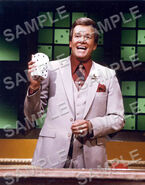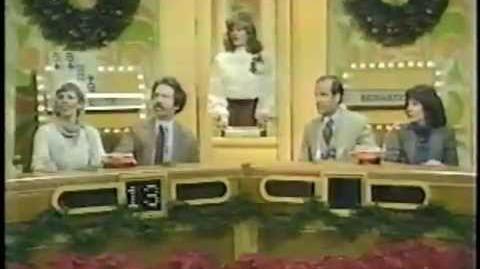| Aired | |
| NBC Daytime, October 27, 1980-November 27, 1981 | |
| Run time | |
| 30 Minutes | |
| Host | |
| Wink Martindale | |
| Dealers | |
| Beverly Mauldin Lee Menning | |
| Announcer | |
| Kenny Williams | |
| Origination | |
| Fountain Theatre, Tropicana Hotel, Las Vegas, Nevada | |
This is chronicling 1980-1981 version of Gambit called Las Vegas Gambit.
Game Format[]
The object of the game was that of blackjack: come as close to 21 as possible without going over (or "busting"). As in blackjack, the cards 2 through 10 were worth their face value; face cards (Kings, Queens and Jacks) counted as 10 and an Ace could count as either 1 or 11.
Martindale asked a series of questions, usually multiple-choice or true-false, to two married couples. The couple who buzzed in and answered the question correctly won control of the next card from the top of a deck of 52 over-sized (but otherwise regulation) playing cards. If a couple buzzed in and missed the question, then the other couple got control of the next card. The first card was shown before the first question, but cards thereafter were presented face down.
Once a couple gained control of a card they had the option of adding it to their own hand or passing it to their opponents. After a couple received any card (whether by choosing to take it themselves or by having a card passed to them from their opponents) they could elect to "freeze" if they were in the lead (neither team was permitted to freeze when the two were tied), preventing them from receiving any additional cards. This rule prevented their opponents from passing cards to them in order to strategically force them to bust.
Once this happened, the other couple answered questions and received a card after each correct answer.
Conditions for winning[]
A game could be won in one of four ways:
- Reaching 21 in any combination, which not only won the game, but also broke the Gambit Jackpot, which started at $500 and went up $500 at the start of each match, except that if it was won with the last card of the day, it started the next day at $500. The highest jackpot was $6,500. On the premiere, it started at $2,500.
- Having their opponents exceed 21 ("bust"), even if the winners had no cards.
- Freezing, and then having the opponents miss a question before getting a higher score without going over 21.
- Having the opponents freeze, and then getting a higher score without going over 21.
Each game won was worth $100, and the first couple to win two games won the match and advanced to the bonus round.
Bonus Round[]
Living Deck[]
For the pilot, a group of 52 audience members each holding a different card. Every time the couple earned a prize, the audience member with the selected card would win the same prize.
Gambit Board[]
For the first half of Las Vegas Gambit, the winning couple played the Gambit Bonus Board. They faced a large game board with 18 numbered video screens. Each screen concealed a prize; along with each prize the couple chose, they received a card added to their hand from the deck.
The game ended in one of three ways:
- The couple elected to stop before reaching 21 (especially if they feared the next card would push them over 21 or in some instances, if they won a desirable prize they wanted to keep) and keep all the prizes they had chosen to that point.
- Going over 21, at which point they lost everything from the board.
- Reaching 21 exactly, wherein they won the Gambit Jackpot and the prizes selected (plus $5,000 in later weeks).
During the early episodes, a couple could elect to stop only when their hand totaled 17 or more.
Special Features[]
Las Vegas Gambit had its own special features, played when a couple stopped or won the end game, including:
- "Take Two" – The couple could pick two numbers on the next turn.
- "Stop or Go" – The dealer would reveal a card, the value of which would be multiplied by $100. The couple could then choose to attempt winning more cash by selecting another card, but would bust if the next card was the same suit as the first card dealt (i.e., if the first card was a club, another club would end the game), and thus lose all the cash accumulated up to that point.
- "100/200/500 Times" – The couple, assuming they did not go over 21, would receive one additional card not counted towards their final hand score, and be awarded $100/$200/$500 times the value of that card, worth $200–$1,100, $400–$2,200, or $1,000–$5,500.
- "Red or Black"
- "Beat the House" – Contestants winning this prize would have the opportunity to play one hand of blackjack "against the house" for $1,000 using standard single-deck rules, with the possible exception being that there did not appear to be any cases in which contestants could "split" a pair (play each card of the pair as the basis of its own hand) or "double down" (draw a single additional card for twice the stakes) on a wager.
Gambit Galaxy[]
The second half of Las Vegas Gambit featured "The Big Numbers", a game borrowed from another Heatter-Quigley game, High Rollers (which Wink would eventually host starting in 1987 in syndication). The couple was presented with a pair of dice and was asked to eliminate the numbers 1 through 9 from a board in front of them. To do this, the couple eliminated numbers that added up to the total they rolled (for instance, if the couple rolled a 10 they could eliminate 4 and 6; 3 and 7; 1, 2, 3, and 4; or any other combination that added to 10). The couple won $100 for each number they eliminated, and if all nine were eliminated, the couple won $5,000 and an accumulating prize package called the "Gambit Galaxy". The highest jackpot was $51,565. In the event a double was rolled (the same number on both dice), an insurance marker was awarded; it could then be used in the event the couple made a bad roll.
This version's last week of shows consisted of reruns from an earlier "Singles Week" (in which teams of two complete strangers were paired up to play the game, and at the end of the week all couples who won a match rolled the dice for the "Gambit Galaxy").
Champions stayed on the show until they were defeated.
| This page uses Creative Commons Licensed content from Wikipedia (view authors). |
Trivia[]
International Versions[]
Cancelled Merchandise[]
A second attempt at doing a board game based on the 1981 version was made by Milton Bradley in 1981, but it ended up getting cancelled before it was manufactured.
Photos[]
Episode Status[]
- The pilot episodes exist. Episodes 1 through 8 and the finale exist. Other episodes exist also, all of them being home recordings. The offiical episode status is unknown.
Video[]
See Also[]
Gambit
Gambit (1979)
Gambit (1985)
Gambit (1990)
Casino
Catch 21
Catch 21 (2019)











